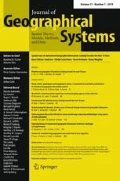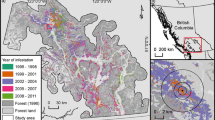Abstract
Epidemic populations of mountain pine beetle highlight the need to understand landscape scale spatial patterns of infestation. The observed infestation patterns were explored using a randomization procedure conditioned on the probability of forest risk to beetle attack. Four randomization algorithms reflecting different representations of the data and beetle processes were investigated. Local test statistics computed from raster representations of surfaces of kernel density estimates of infestation intensity were used to identify locations where infestation values were significantly higher than expected by chance (hot spots). The investigation of landscape characteristics associated with hot spots suggests factors that may contribute to high observed infestations.








Similar content being viewed by others
References
Bailey T, Gatrell A (1995) Interactive spatial data analysis. Longman Group Limited, Essex
Barclay H, Safranyik L, Linton D (1998) Trapping mountain pine beetles Dendroctonus ponderosae (Coleoptera: Scolytidae) using pheromone-baited traps: effects of trapping distance. J Entomol Soc Br Columbia 95:25–31
Bentz B, Amman G, Logan L (1993) A critical assessment of risk classification systems for the mountain pine beetle. For Ecol Manag 61:349–366
Besag J, Newell J (1991) The detection of clusters in rare diseases. J R Stat Soc 154:143–155
Boots B (2002) Local measures of spatial association. Ecoscience 9:168–176
Boots BN, Getis A (1988) Point Pattern Analysis. Scientific Geography Series, vol 8. Sage Publications, Newbury Park
Conner E, Simberloff D (1986) Competition, scientific method, and null models in ecology. Am Sci 74:155–162
Davis JH, Howe RW, Gregory JD (2000) A multi-scale spatial analysis method for point data. Landsc Ecol 15:99–114
Diggle P (1985) A kernel method for smoothing point process data. Appl Stat 34:138–147
Edgington ES (1995) Randomization tests, 3rd edn. Marcel Dekker Inc, New York
Fortin MJ, Jacquez G (2000) Randomization tests and spatially autocorrelated data. Bull Ecol Soc Am 81:201–205
Fotheringham A (1997) Trends in quantitative methods I: stressing the local. Prog Hum Geogr 21:88–96
Fotheringham S, Brunsdon C (1999) Local forms of spatial analysis. Geogr Anal 31:340–358
Getis A, Boots B (1978) Models of spatial processes: an approach to the study of point, line and area patterns. Cambridge University Press, Cambridge
Hopping GR, Beall G (1948) The relation of diameter of lodgepole pine to incidence of attack by the bark beetle Dendroctonus monticolae Hopkins. For Chron 24:141–145
Kelsall J, Diggle P (1995) Non-parametric estimation of spatial variation in relative risk. Stat Med 14:2335–2342
Kulldorff M, Tango T, Park PJ (2003) Power comparisons for disease clustering tests. Comput Stat Data Anal 42:665–684
Leckie D, Gillis M (1995) Forest inventory in Canada with emphasis on map production. For Chron 71:74–88
Legendre P, Dale MRT, Fortin MJ, Gurevitch J, Hohn M, Myers D (2002) The consequence of spatial structure for the design and analysis of ecological field surveys. Ecography 25:601–615
Legendre P, Fortin MJ (1989) Spatial pattern and ecological analysis. Vegetatio 80:107–138
Mitchell R, Preisler H (1991) Analysis of spatial patterns of lodgepole pine attacked by outbreak populations of the mountain pine beetle. For Sci 37:1390–1408
O’Sullivan D, Unwin DJ (2003) Geographic information analysis. Wiley, Hoboken
Parminter J (1998) Natural disturbance ecology. In: Voller J, Harrison S (eds) Conservation biology principles for forested landscapes. UBC Press, Vancouver, pp 3–35
Province of British Columbia (1996) Gridded DEM specifications. Ministry of Sustainable Resource Management, Victoria
Safranyik L, Shrimpton D, Whitney H (1974) Management of lodgepole pine to reduce losses from the mountain pine beetle. Natural Resources Canada, Canadian Forest Service, Pacific Forestry Centre, Victoria
Shore T, Safranyik L (1992) Susceptibility and risk rating systems for the mountain pine beetle in lodgepole pine stands. Natural Resources Canada, Canadian Forest Service, Pacific Forestry Centre, Victoria
Shore T, Safranyik L, Lemieux J (2000) Susceptibility of lodgepole pine strands to the mountain pine beetle: testing of a rating system. Can J For Res 30:44–49
Silverman B (1986) Density estimation for statistics and data analysis. Chapman Hall, New York
Stine P, Hunsaker C (2001) An introduction to uncertainty issues for spatial data used in ecological applications. In: Hunsaker G, Goodchild M, Friedl M, Case T (eds) Spatial uncertainty in ecology: implications for remote sensing and GIS applications. Springer, Berlin Heidelberg New York, pp 91–107
Westfall J (2004) 2004 Summary of Forest Health Conditions in British Columbia. British Columbia Ministry of Forests, Forest Practices Branch, p 43
Wulder MA, Seeman D, Dymond C, Shore T, Riel B (2004) Arc/Info Macro Language (AML) scripts for mapping susceptibility and risk of volume losses to mountain pine beetle in British Columbia. Natural Resources Canada, Canadian Forest Service, Pacific Forestry Centre, Victoria
Acknowledgements
This project was funded by the Government of Canada through the Mountain Pine Beetle Initiative, a 6 year, $40 million Program administered by Natural Resources Canada, Canadian Forest Service. Publication does not necessarily signify that the contents of this report reflect the views or policies of Natural Resources Canada—Canadian Forest Service. The authors are grateful for the constructive comments of two anonymous reviewers that helped enhance the final presentation.
Author information
Authors and Affiliations
Corresponding author
Rights and permissions
About this article
Cite this article
Nelson, T., Boots, B. Identifying insect infestation hot spots: an approach using conditional spatial randomization. J Geograph Syst 7, 291–311 (2005). https://doi.org/10.1007/s10109-005-0005-6
Published:
Issue Date:
DOI: https://doi.org/10.1007/s10109-005-0005-6




